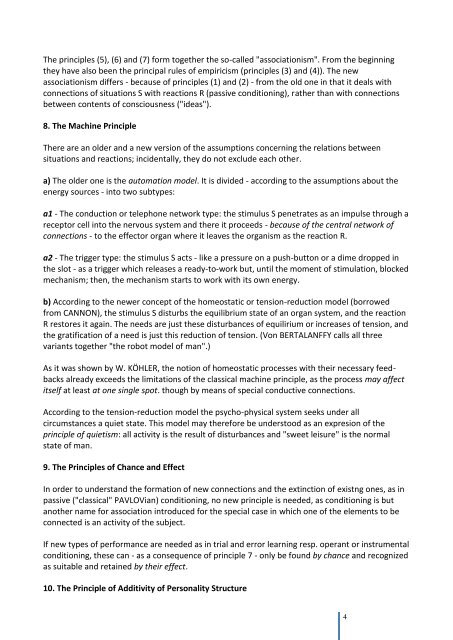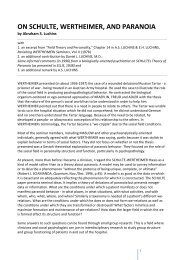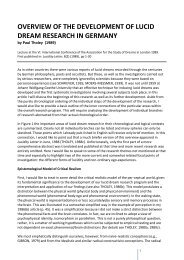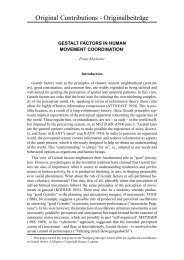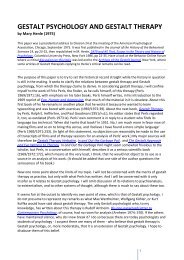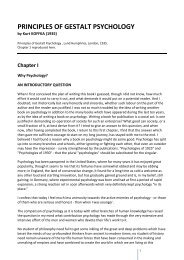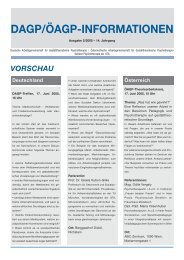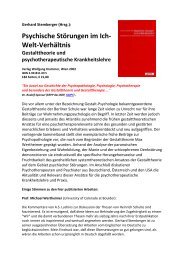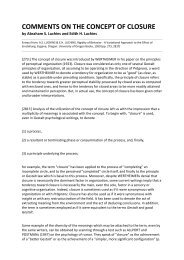pdf-Download - Society for Gestalt Theory and its Applications (GTA)
pdf-Download - Society for Gestalt Theory and its Applications (GTA)
pdf-Download - Society for Gestalt Theory and its Applications (GTA)
You also want an ePaper? Increase the reach of your titles
YUMPU automatically turns print PDFs into web optimized ePapers that Google loves.
The principles (5), (6) <strong>and</strong> (7) <strong>for</strong>m together the so-called "associationism". From the beginning<br />
they have also been the principal rules of empiricism (principles (3) <strong>and</strong> (4)). The new<br />
associationism differs - because of principles (1) <strong>and</strong> (2) - from the old one in that it deals with<br />
connections of situations S with reactions R (passive conditioning), rather than with connections<br />
between contents of consciousness ("ideas").<br />
8. The Machine Principle<br />
There are an older <strong>and</strong> a new version of the assumptions concerning the relations between<br />
situations <strong>and</strong> reactions; incidentally, they do not exclude each other.<br />
a) The older one is the automation model. It is divided - according to the assumptions about the<br />
energy sources - into two subtypes:<br />
a1 - The conduction or telephone network type: the stimulus S penetrates as an impulse through a<br />
receptor cell into the nervous system <strong>and</strong> there it proceeds - because of the central network of<br />
connections - to the effector organ where it leaves the organism as the reaction R.<br />
a2 - The trigger type: the stimulus S acts - like a pressure on a push-button or a dime dropped in<br />
the slot - as a trigger which releases a ready-to-work but, until the moment of stimulation, blocked<br />
mechanism; then, the mechanism starts to work with <strong>its</strong> own energy.<br />
b) According to the newer concept of the homeostatic or tension-reduction model (borrowed<br />
from CANNON), the stimulus S disturbs the equilibrium state of an organ system, <strong>and</strong> the reaction<br />
R restores it again. The needs are just these disturbances of equilirium or increases of tension, <strong>and</strong><br />
the gratification of a need is just this reduction of tension. (Von BERTALANFFY calls all three<br />
variants together "the robot model of man".)<br />
As it was shown by W. KÖHLER, the notion of homeostatic processes with their necessary feedbacks<br />
already exceeds the limitations of the classical machine principle, as the process may affect<br />
<strong>its</strong>elf at least at one single spot. though by means of special conductive connections.<br />
According to the tension-reduction model the psycho-physical system seeks under all<br />
circumstances a quiet state. This model may there<strong>for</strong>e be understood as an expresion of the<br />
principle of quietism: all activity is the result of disturbances <strong>and</strong> "sweet leisure" is the normal<br />
state of man.<br />
9. The Principles of Chance <strong>and</strong> Effect<br />
In order to underst<strong>and</strong> the <strong>for</strong>mation of new connections <strong>and</strong> the extinction of existng ones, as in<br />
passive ("classical" PAVLOVian) conditioning, no new principle is needed, as conditioning is but<br />
another name <strong>for</strong> association introduced <strong>for</strong> the special case in which one of the elements to be<br />
connected is an activity of the subject.<br />
If new types of per<strong>for</strong>mance are needed as in trial <strong>and</strong> error learning resp. operant or instrumental<br />
conditioning, these can - as a consequence of principle 7 - only be found by chance <strong>and</strong> recognized<br />
as suitable <strong>and</strong> retained by their effect.<br />
10. The Principle of Additivity of Personality Structure<br />
4


